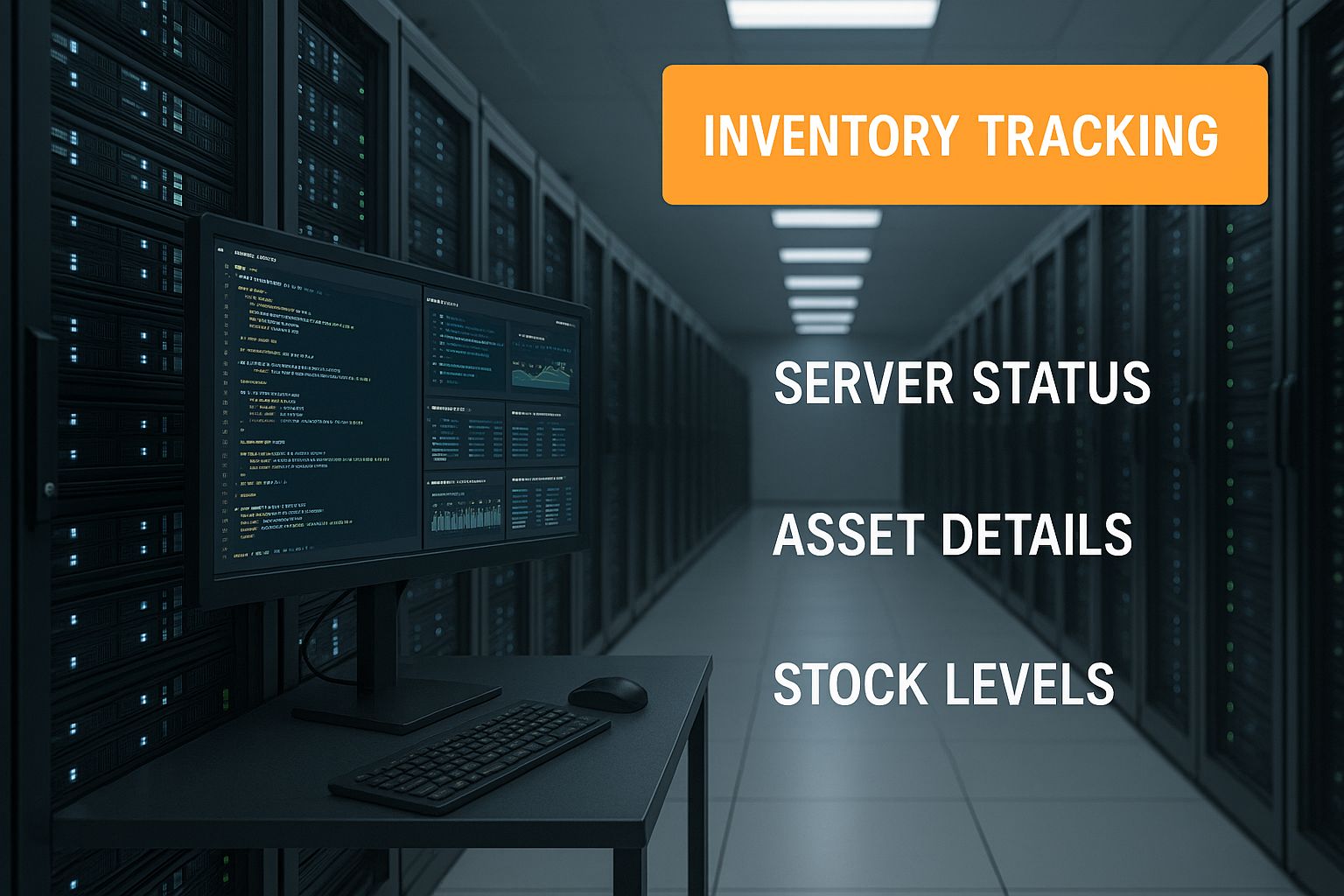Imagine you're the air traffic controller for your company's entire technology stack—every server, software license, cloud service, and even the tech specialists on your team. That, in a nutshell, is IT resource management. It’s the art and science of making sure the right tech assets are in the right place, at the right time, without breaking the bank.
What Is IT Resource Management, Really?
At its heart, IT resource management is the whole process of planning, scheduling, and allocating your technology assets to squeeze every last drop of value out of them. This isn't just about keeping a spreadsheet of laptops and servers anymore. Today, it covers everything from cloud computing credits and SaaS subscriptions to the very specific skills of your IT pros.
Think of it like this: your IT resources are the fuel that powers your business engine. If you don't manage that fuel properly, you're either leaking it all over the place through waste and forgotten subscriptions, or you're running on fumes and can't keep up with what the business needs. Good management ensures every drop of that fuel is actually pushing the company forward.
Why Strategic Control Matters More Than Ever
This isn't just a "nice-to-have" anymore; it's become absolutely critical as tech spending goes through the roof. In fact, worldwide IT spending is projected to hit a staggering $5.61 trillion in 2025. That's a 9.8% jump from 2024, with a big chunk of that growth fueled by generative AI. You can dig into the numbers and what’s driving them in Gartner's latest forecast.
With budgets swelling like that, the pressure is on to prove you’re getting a return on every dollar. Without a solid IT resource management strategy, companies are practically setting money on fire through underused assets and "license sprawl"—that all-too-common problem of paying for software nobody is even using.
A classic example we see all the time is in the Atlassian ecosystem, where inactive user accounts can quietly inflate your bill. Learning how to properly deactivate Jira users is a perfect, tactical example of resource management that delivers immediate, tangible savings.
The real goal of IT resource management is to strike a perfect balance where technology supply meets business demand—no waste, no friction, just smooth sailing that allows for innovation.
Core Components of IT Resource Management
To really get a handle on this, it helps to break down the different types of resources you're juggling. Each one needs its own approach to make sure you're getting the most out of it.
Here's a quick look at the main categories involved.
Core Components of IT Resource Management
| Resource Category | Includes | Primary Management Goal |
|---|---|---|
| Hardware Assets | Servers, laptops, mobile devices, networking gear | Track the full lifecycle, keep up with maintenance, and plan for upgrades or disposal. |
| Software Assets | Licenses (SaaS & on-prem), subscriptions, applications | Optimize license usage, stay compliant, and get rid of redundant software. |
| Cloud Resources | IaaS, PaaS, SaaS, server instances, storage | Monitor what you're using, manage costs (FinOps), and ensure you can scale when needed. |
| Human Capital | IT staff, developers, specialists, contractors | Match skills to project needs, manage workloads effectively, and support professional growth. |
| Data & Network | Databases, data storage, network bandwidth | Ensure data is always available, secure, and flowing efficiently across the business. |
Understanding these distinct areas is the first step toward building a cohesive strategy that treats all your tech assets not as costs, but as valuable investments driving your business.
The Four Pillars of a Winning Strategy
A solid IT resource management strategy really boils down to four core pillars. I like to think of them as the load-bearing columns holding up your entire technology structure. If one of them is shaky, the whole building gets wobbly. Getting them to work in harmony is the key to creating a framework that's both balanced and resilient.
The first and most fundamental pillar is Asset Management. In its simplest form, this is just about knowing exactly what you own. We're talking about everything from the physical servers humming away in your data center to the countless SaaS licenses your teams use every single day. If you don't have a clear inventory, you're essentially flying blind.
This image of a modern data center gives you a sense of the complexity of just tracking physical hardware, which is only one piece of the puzzle.

A truly comprehensive inventory has to go beyond hardware. It needs to account for all your software, cloud services, and licenses to give you a complete picture of your operations.
Proactive Capacity and Financial Planning
Next up is Capacity Planning. Imagine you're managing a city's power grid. You have to anticipate demand spikes to prevent blackouts, but you also can't afford to waste energy by overproducing. It's the same in IT. This pillar is all about forecasting your need for cloud compute power, storage, and network bandwidth to dodge performance bottlenecks or wasteful overprovisioning.
The third pillar is Financial Management, which you'll often hear talked about under the FinOps (Financial Operations) umbrella. This is much more than just budgeting. It's about building a culture of cost-awareness and squeezing the maximum business value out of every single dollar spent on technology.
This financial discipline is more critical than ever. Spending trends are on a sharp upward curve, with 64% of companies expecting their IT budgets to grow in 2025. Software spending, in particular, is on track to break $1 trillion for the second consecutive year—an incredible 88% growth since 2017. You can dig into more technology statistics and see what they signal for budget planning.
A well-executed IT resource management plan transforms the IT department from a cost center into a strategic business partner, directly connecting technology investment to business outcomes.
The Overlooked Human Element
Last but certainly not least is the fourth pillar: Human Capital Management. Your tech is only as good as the people who manage and use it. This pillar focuses on making sure you have the right people with the right skills working on the right projects. It involves:
- Skill Mapping: Getting a clear picture of the technical expertise you have in-house and identifying any gaps.
- Workload Balancing: Spreading tasks effectively to prevent burnout and avoiding that classic scenario where critical knowledge is locked up with just one person.
- Strategic Allocation: Putting your most skilled specialists on high-impact projects where they can deliver the most value.
When all four of these pillars—Asset Management, Capacity Planning, Financial Management, and Human Capital—are strong and working together, your IT resource management strategy becomes a powerful engine for efficiency and growth. It allows you to get a handle on costs, reduce risks, and ensure your technology stack is perfectly tuned to drive your business goals.
What Global IT Spending Trends Mean for Your Business

It’s easy to get tunnel vision when you’re focused on your own company’s budget, but your IT resource management strategy doesn't exist in a vacuum. It’s part of a much bigger, global story. By zooming out and looking at worldwide IT spending trends, you can spot market shifts and get a real strategic edge.
These high-level numbers are more than just trivia; they’re a roadmap to where the industry is heading. For instance, forecasts for 2025 show some fascinating regional differences. Europe is gearing up for a massive 8.7% jump in IT spending to $1.28 trillion, the biggest leap since 2021. In contrast, the Middle East and North Africa (MENA) are seeing a more steady 4.2% growth, hitting $175.5 billion. Meanwhile, Southeast Asia is another hotbed of activity, with spending projected to rise 7% to nearly $47 billion across five key economies.
Turning Global Insights into Local Wins
So, what does all this mean? These different investment patterns tell a clear story. Europe’s spending spree is largely fueled by a huge push into cloud infrastructure and cybersecurity. Southeast Asia’s growth, on the other hand, is all about rapid digitalization across the board.
By keeping an eye on these macro-level movements, you can anticipate what's coming next for your own organization—whether you're a local shop or a multinational giant.
Knowing where the global market is headed lets you proactively adjust your own resource allocation. It helps you invest in the right technologies and avoid getting caught flat-footed by the next big shift.
This kind of foresight is what separates good budget planning from great budget planning. If global trends show a spike in spending on continuous integration tools, you'd better be ready. It’s smart to learn how to control your CI budget before those costs start to creep up and surprise you.
How to Align Your Resources for Real Impact
At the end of the day, it's all about positioning your IT resources to succeed in a connected world. That means looking beyond your own team's needs and aligning your strategy with the bigger picture.
Here are a few practical ways to start applying these global insights:
- Benchmark Your Budget: How does your spending on cloud, software, and hardware stack up against regional averages? This simple comparison can quickly reveal if you’re overspending or falling behind.
- Anticipate Supply Chain Hiccups: A surge in demand for specific hardware in one part of the world can create a ripple effect, impacting prices and availability everywhere. Stay ahead of it.
- Double Down on Productivity: As you bring in new resources, make sure you have a plan to get the most out of them. A solid understanding of how to improve productivity at work ensures your investments deliver real value.
When you connect global IT spending to your day-to-day decisions, abstract data becomes a powerful tool. It’s the key to smarter, more effective IT resource management.
Actionable Tactics for Smarter Resource Optimization
Alright, let's move from high-level strategy to the practical, on-the-ground moves that actually make a difference. This is where effective IT resource management starts to pay real dividends. The idea is to build a playbook of proven tactics that deliver immediate, measurable results in both cost savings and efficiency.
These aren't just abstract concepts; they are concrete actions. By putting a few key optimizations into practice, you can start reclaiming budget and time almost immediately. It all starts with taking an honest look at where you are now and committing to making things better, one step at a time.
Perform Regular Resource Audits
The first, and arguably most important, tactic is the humble resource audit. Think of it as a much-needed "spring cleaning" for your entire tech stack. The goal is simple: systematically hunt down and eliminate waste by asking tough questions about every single asset you own.
Why It Works: Audits give you the cold, hard data needed to stop paying for "shelfware"—software that gets purchased but sits on a digital shelf, collecting dust. They shine a light on forgotten subscriptions, underpowered hardware, and redundant apps, which are often the biggest silent killers of your IT budget.
To get started, try scheduling quarterly reviews of all your software licenses, cloud instances, and hardware. For each resource, create a simple checklist: Is it actually being used? Who's using it? Is the value it provides worth the cost? This process doesn't just illuminate waste; it builds the foundation for every other optimization you'll make.
Adopt Automation for License Management
Let’s be honest: manually tracking user activity across dozens of different platforms isn't just a drag—it's a recipe for expensive mistakes. This is where automation becomes your best friend, especially in complex ecosystems like Atlassian. For example, a good tool can automatically scan for inactive users and flag them for deactivation.
This proactive approach stops you from paying for licenses that belong to employees who have left the company or switched roles. For a more detailed look at how this works in practice, our guide on automated license optimization for Jira breaks down a clear framework for setting this up.
Master Cloud Cost Management
If you've ever been shocked by a bill from AWS or Azure, you know how quickly cloud costs can spiral without disciplined oversight. This is where a dedicated FinOps mindset is no longer a "nice-to-have" but an absolute necessity. It’s all about creating a culture of cost-awareness and actively managing your cloud spend, rather than just reacting to it.
Why It Works: It shifts the responsibility for cloud costs from a central IT team to the engineers and product teams who are actually using the resources. This simple change encourages smarter, more efficient architecture and puts an end to wasteful "always-on" configurations for things like development and testing environments.
Putting a few effective cloud cost optimization strategies into play can produce some serious savings. Key actions include:
- Right-Sizing Instances: Don't pay for a Ferrari when a sedan will do. Match your computing power to what your workload actually needs.
- Leveraging Spot Instances: For non-critical jobs, use lower-cost, interruptible instances. It's a fantastic way to cut costs on tasks that can handle a little downtime.
- Setting Budgets and Alerts: Be proactive. Set up spending budgets and alerts so you know when costs are trending up, long before the final bill arrives.
Tackling License Sprawl in Your Atlassian Suite
Let's shift gears from broad strategies to a very real, and often expensive, problem that lands on IT desks every day: license sprawl within the Atlassian suite. If your teams rely on tools like Jira and Confluence, you already know how vital they are. You also know that their per-user licensing model means costs can spiral if you're not paying attention.
This is where license bloat becomes a major headache. Think of it as a slow, silent leak in your IT budget. It happens when you keep paying for user licenses that nobody is actually using. These "ghost users" could be former employees, contractors whose projects wrapped up months ago, or even current team members who switched roles and no longer need access.
The Hidden Costs of Inactive Users
This isn't just a minor administrative annoyance—it hits your bottom line, hard. Each of those inactive accounts represents pure, wasted spend. For a large organization, this can easily add up to thousands, or even tens of thousands, of dollars every single year.
And the cost isn't just financial. Dormant accounts are also a security risk, creating potential backdoors for unauthorized access if they aren't properly deprovisioned.
The real test of modern IT resource management isn't just about the big-ticket items. It's found in plugging these small, recurring leaks. One inactive license might seem trivial, but hundreds of them across multiple platforms can cripple a budget and weaken your security.
A huge part of efficient IT resource management is getting a handle on your software assets. A key tactic here involves managing inactive software licenses, which is especially critical in today's subscription-heavy world where costs are constant and ongoing.
An Automated Solution for Atlassian
Let's be honest: nobody wants to manually audit hundreds or thousands of users, cross-referencing their last login date just to find who's inactive. It's a tedious, mind-numbing task that’s begging for human error.
This is exactly where targeted automation comes in. Tools from the Atlassian Marketplace, like User Deactivator for Jira, were built specifically to solve this problem.
These apps plug right into your Atlassian instance and run scheduled, automated checks to pinpoint users who haven't logged in for a set period, like 90 days. Instead of an admin spending hours running reports and deactivating users one-by-one, the tool does the heavy lifting for them.
Here’s a quick look at how a tool like this gives you a clear dashboard to manage user activity.

The dashboard immediately flags inactive users and lets an admin deactivate them in bulk, turning what was once a multi-hour manual slog into just a few clicks. This is IT resource management in action—using a smart, specialized tool to automate a repetitive job, slash costs, and tighten up security.
To see just how much time you can get back, here’s a quick comparison of the manual process versus an automated one.
Manual vs. Automated Atlassian License Management
| Task | Manual Process (Hours/Month) | Automated Process (Minutes/Month) |
|---|---|---|
| Identifying Inactive Users | 4 – 6 | 5 |
| Cross-Referencing with HR Data | 2 – 3 | 0 (Integrated) |
| Deactivating Users Individually | 2 – 4 | 2 |
| Generating Savings Reports | 1 – 2 | 1 |
| Total Time | 9 – 15 Hours | ~8 Minutes |
The numbers speak for themselves. Automation gives you back precious hours that can be spent on strategic initiatives instead of tedious housekeeping.
This approach doesn't just save money by freeing up expensive licenses; it also helps you stay compliant by enforcing clean, consistent user access policies. For any organization trying to get a better grip on its Atlassian spending, exploring a Jira license cost optimization framework can uncover some serious savings. By putting an automated deactivation process in place, you directly attack waste and turn a persistent cost leak into a well-managed resource.
Your Questions on IT Resource Management Answered
As you start putting these ideas into practice, you're bound to run into some real-world questions. Getting IT resource management right isn't just about knowing the theory; it’s about having the confidence to handle the challenges that pop up along the way.
Think of this section as your practical FAQ. We're here to clear up common uncertainties and give you the direct answers you need to move forward.
What Is the First Step for a Small Business?
If you're a small business just dipping your toes into IT resource management, the single most important first step is to create a complete inventory of all your tech assets. This doesn't need to be a massive undertaking—a well-organized spreadsheet is often the perfect place to start.
Your inventory should log everything you own and subscribe to:
- Hardware: Every laptop, server, monitor, and piece of networking gear.
- Software: All your licenses, from Microsoft 365 to specialized design tools.
- Cloud Services: Don't forget any subscriptions, like hosting, cloud storage, or SaaS platforms like Atlassian.
This simple list is the foundation for everything else. It gives you the raw data you need to spot waste, keep an eye on renewals, and make much smarter purchasing decisions down the road.
An up-to-date asset inventory isn't just a nice-to-have; it's the bedrock of financial control and security. It turns a long list of unknown variables into facts you can actually manage.
How Can I Measure the ROI of Our Efforts?
Measuring the return on investment (ROI) of IT resource management is a two-sided coin: you have to track both direct cost savings and crucial gains in efficiency.
On one side, you have the hard numbers. This is where you calculate savings from axing unused software licenses, downsizing over-provisioned cloud servers, or negotiating better deals with vendors. It's the most straightforward part of the ROI equation.
But don't forget the other side: productivity improvements. Think about how much time your IT team gets back when they aren't manually deprovisioning users or chasing down license renewals. Quantifying these time savings gives you a full picture of the value you're creating. A fantastic example is the time saved by automating user management; for a real-world case, check out how one company streamlined its process for provisioning Confluence users.
How Does This Impact Cybersecurity?
Good IT resource management is a cornerstone of a solid cybersecurity strategy. When you know exactly what hardware and software you have, you eliminate dangerous blind spots. It ensures every single asset is accounted for, patched, and updated, which closes the door on many common security vulnerabilities.
A huge piece of this is managing the user lifecycle. Promptly deactivating the accounts of former employees and contractors isn't just a cleanup task—it's a critical security measure that prevents unauthorized access to sensitive company data. This disciplined approach also helps you kill "shadow IT"—those unapproved apps and devices that are notorious weak points for cyberattacks.
Are Automation Tools Really Necessary?
Look, if you're a tiny team, you might be able to get by with manual processes for a little while. But as soon as your organization starts to scale, automation tools stop being a luxury and become absolutely essential. Trying to manually track hundreds of user licenses and their activity is not only a massive time sink but also incredibly prone to human error.
Automation tools take care of these repetitive, detailed tasks with perfect consistency. This frees up your skilled IT pros to focus on strategic work that actually moves the business forward, instead of getting buried in administrative busywork. For a high-value ecosystem like Atlassian, an automation tool provides a clear and fast ROI by cutting down on license waste and tightening up security.
Ready to stop wasting money on unused Atlassian licenses? resolution Reichert Network Solutions offers User Deactivator, the leading app for automatically identifying and disabling inactive users in Jira, Confluence, and Bitbucket. Optimize your license costs and enhance security with User Deactivator today.
